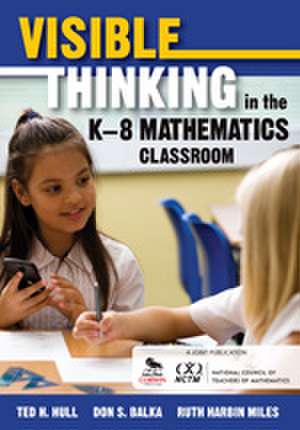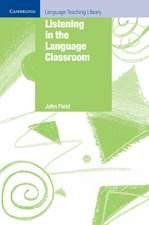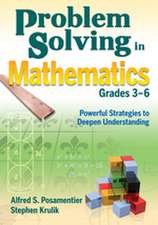Visible Thinking in the K–8 Mathematics Classroom
Autor Ted H. Hull, Don S. Balka, Ruth Harbin Milesen Limba Engleză Paperback – 23 mar 2011
- Increased class participation
- Development of metacognitive thinking and problem-solving skills.
Helpful features include vignettes, relevant word problems, classroom scenarios, sample problems, lesson adaptations, and easy-to-follow examples of each strategy in action. The authors also explain how students can demonstrate their thinking using calculators and online tools. The final chapter outlines steps maths leaders can take to implement visible thinking and maximize mathematics comprehension for all students.
Preț: 281.25 lei
Nou
53.82€ • 56.34$ • 44.53£
Carte tipărită la comandă
Livrare economică 07-21 aprilie
Specificații
ISBN-10: 1412992052
Pagini: 184
Dimensiuni: 178 x 254 x 13 mm
Greutate: 0.38 kg
Ediția:1
Editura: SAGE Publications
Colecția Corwin
Locul publicării:Thousand Oaks, United States
Recenzii
"This book will help you, your students and your school. The author merges what we know works in mathematical problem solving, metacognition, social learning theory, and formative assessment. The examples display grade-specific ways to help individual students tackle brainteasers, whole-class concepts, and adaptations of traditional textbook exercises."
"The author gives an excellent overview of what visual thinking is, why it is important, and how to implement it in the classroom. The text offers great advice for addressing many of the Common Core State Standards for Mathematics Habits of Mind, including making sense of problems and communicating mathematical reasoning."
Cuprins
Acknowledgments
About the Authors
Part I. Preparing the Foundation
1. What Is Visible Thinking?
Understanding Mathematical Concepts
Thinking as a Mathematical Premise
Visible Thinking in Classrooms
Visible Thinking Scenario 1: Area and Perimeter
Summary
2. How Do Students Learn Mathematics?
What Is Thinking?
What Does Brain Research Indicate About Thinking and Learning?
What Is Mathematical Learning?
What Are Thinking and Learning Themes From Research?
Example Problems Revisited
Visible Thinking Scenario 2: Addition of Fractions
Summary
3. What Is Happening to Thinking in Mathematics Classrooms?
Improvement Initiatives and Visible Thinking
Visible Thinking Scenario 3: Subtraction With Regrouping
Summary
Part II. Promoting Visible Thinking With an Alternative Instructional Model
4. How Do Effective Classrooms Depend on Visible Thinking?
What Are Strategies, Conditions, and Actions?
Practice Into Action
Technology as Visible Thinking
Visible Thinking Scenario 4: Division
Summary
5. How Are Long-Term Changes Made?
Enhancing Student Learning
Teaching Approaches
Visible Thinking Scenario 5: Mixed Numerals
Visible Thinking Scenario 6: Place Value
Summary
6. How Are Short-Term Changes Made?
Pitfalls and Traps
Strategy Sequence
The Relationships Among the Strategy Sequence, Conditions, and Goals
Visible Thinking Scenario 7: Basic Addition and Subtraction Facts
Visible Thinking Scenario 8: Exponents
Summary
7. How Are Lessons Designed to Achieve Short-Term and Long-Term Changes?
The Current Approach to Teaching Mathematics
Elements of an Alternative Instructional Model
Types of Problems
Summary
Part III. Implementing the Alternative Model at Different Grade Levels
8. How Is Thinking Made Visible in Grades K–2 Mathematics?
Brainteaser Problem Example
Group-Worthy Problem Example
Transforming Problem Example
Summary
9. How Is Thinking Made Visible in Grades 3–5 Mathematics?
Brainteaser Problem Example
Group-Worthy Problem Example
Transforming Problem Example
Summary
10. How Is Thinking Made Visible in Grades 6–8 Mathematics?
Brainteaser Problem Example
Group-Worthy Problem Example
Transforming Problem Example
Summary
Part IV. Continuing the Work
11. How Do Teachers, Leaders, and Administrators Coordinate Their Efforts to Improve Mathematics Teaching and Learning?
Working With Administrators
Embedding Lessons Into the Curriculum
Providing Professional Development
Co-planning and Co-teaching
Summary
Appendix A: Research Support for Visible Thinking Strategies, Conditions, and Actions
Appendix B: Lessons Using Technology: Additional Materials
References
Index
Notă biografică
Ted H. Hull completed 32 years of service in public education before retiring and opening Hull Educational Consulting. He served as a mathematics teacher, K-12 mathematics coordinator, middle school principal, director of curriculum and instruction, and a project director for the Charles A. Dana Center at the University of Texas in Austin. While at the University of Texas, 2001 to 2005, he directed the research project ¿Transforming Schools: Moving from Low-Achieving to High Performing Learning Communities.¿ As part of the project, Hull worked directly with district leaders, school administrators, and teachers in Arkansas, Oklahoma, Louisiana, and Texas to develop instructional leadership skills and implement effective mathematics instruction. Hull is a regular presenter at local, state, and national meetings. He has written numerous articles for the NCSM Newsletter, including "Understanding the Six Steps of Implementation: Engagement by an Internal or External Facilitator" (2005) and "Leadership Equity: Moving Professional Development into the Classroom" (2005), as well as "Manager to Instructional Leader" (2007) for the NCSM Journal of Mathematics Education Leadership. He has been published in the Texas Mathematics Teacher (2006), Teacher Input Into Classroom Visits: Customized Classroom Visit Form. Hull was also a contributing author for publications from the Charles A. Dana Center: Mathematics Standards in the Classroom: Resources for Grades 6¿8 (2002) and Middle School Mathematics Assessments: Proportional Reasoning (2004). He is an active member of Texas Association of Supervisors of Mathematics (TASM) and served on the NCSM Board of Directors as regional director for Southern 2.











